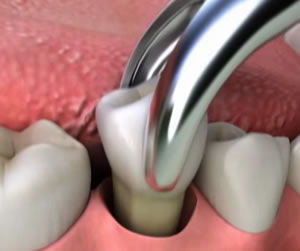A tooth extraction refers to the procedure of removing a tooth from its socket.
Procedure On Removing A Tooth
First, a local anesthetic is applied to make the procedure more comfortable. A dental instrument called an elevator is used to wiggle the tooth in its socket. After the tooth is loosened it is removed using forceps.
Extractions Possible Complications
Like most other procedures, tooth extraction is not free of possible complications. You should be aware there is a slight chance of infection, tenderness, prolonged bleeding, dry socket and loosening of neighboring teeth or their fillings or crowns.
Importance Of Replacing The Missing Tooth
You need to be aware of the importance of replacing a missing tooth. Why? Once a tooth is removed, the space createded by the missing tooth will allow the surrounding teeth to shift into that space. This shift could cause a misalignment in your mouth that can result in chewing or jaw-joint problems. These shifted teeth are harder to clean, making them more susceptible to gum disease, decay or even additional tooth loss. It is important to replace the tooth with a dental appliance such as a bridge or implant.
Pulling A Repairable Tooth
In some instances you may be considering the option of removing a tooth rather than simply repairing it. While it may be less expensive in the short run, in the long run it may cost you more. Remember, once a tooth is removed, more dentistry (bone grafts, implants or bridgework) may be necessary.










